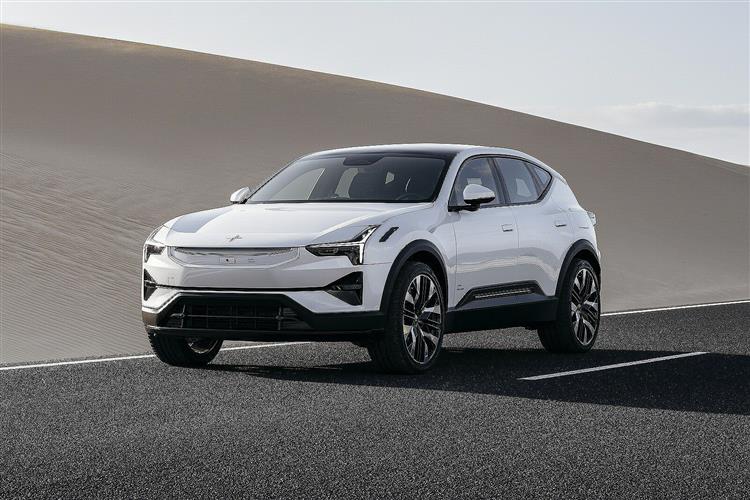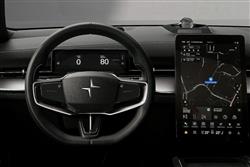THREE'S PROUD (some text hidden) SECTIONED_new_polestar3_2025
By Jonathan Crouch
This improved Polestar 3 takes its brand even more confidently into the luxury SUV segment. Jonathan Crouch takes a look.
Ten Second Reviewword count: 61
Polestar is evolving. And proof of that comes with the Polestar 3, here usefully improved with an 800V architecture. It was the company's first large SUV and of course is fully electric, with a sporty vibe that pitches it directly against rivals like BMW's iX and the Mercedes EQE SUV. The brand even claims it 'drives like a sportscar'; we'll see.
Backgroundword count: 230
It's been astonishing just how quickly the Polestar brand has grown, to begin with effectively on the back of just one model, the Polestar 2. Particularly as that car wasn't even (overtly anyway) part of the SUV genre that's most quickly driving sales in the electric market at present. The Polestar 3 very much is, this high-end large luxury EV originally launched in 2024 to evolve the company's design identity, aiming (in the company's words) to bring the 'sport' back to this class of SUV. Since then, that design identity has moved on further still with two additional Polestar models, the slightly smaller 4 (a mid-sized SUV) and the slightly larger 5 (a four-door GT), which you might expect to both share engineering with the car we have here. Actually though, this '3' is quite distinct. Unlike its showroom stablemates, it's built for Europe in the US, rather than in China. And uses different underpinnings, an SPA2 chassis borrowed from former Polestar owners Volvo, part of a drivetrain shared with that Swedish maker's 7-seat electric SUV, the EX90. As with the EX90, this Polestar 3 got a major update in Autumn 2025, with changes to the car's core computing system, a revised large battery and the substitution of the previous old-tech 400V electrical architecture with a faster-charging 800V set-up. It's that improved model we're going to tell you about here.
Driving Experienceword count: 407
'This is not a car to drive to the kindergarten', says Polestar, which seems ironic since that's exactly what an awful lot of Polestar 3s will be used for. The point the brand is trying to make is that this should be considered amongst more engaging large crossover EVs; think more BMW iX or Porsche Macan Electric than Mercedes EQE. The power outputs are tuned to fit with this emphasis on handling engagement. There's a base 'Rear motor' version with 333hp and a 375 mile range from its 92kWh battery. It makes 62mph in 6.5s. But many customers will want more EV range and a twin motor AWD set-up; in the mid-level 'Dual motor' version, that produces 544hp and 740Nm of torque, allowing 62mph to be dispatched in 4.7s on the way to 140mph. Range from this variant's larger 106kWh battery is 394 miles. The top 'Performance' twin motor variant has a 680hp output (with 870Nm of torque) and trims the sprint time to 3.9s. It also uses the 106kWh battery and range is 368 miles. The 'Performance' twin motor version should feel sharper through the turns, sitting 13mm lower than the standard car, with a shorter, stiffer suspension set-up. Whatever your choice though, the brand claims the car will be 'fun to drive': Chief Engineer Joakim Rydholm asserts that 'the 3 will breathe and flow a bit more than the Polestar 2'. You'll need to be aware that you have to stretch to one on the twin motor models if you want air suspension. This updated model benefits from a new in-house-developed permanent magnet synchronous rear motor that delivers higher output. Plus the front motor now features automatic disconnect functionality when not needed, just as on Dual motor versions of Polestar 2, improving efficiency and range during everyday driving. The new rear motor also means the power balance has shifted to a greater rear bias than before. Combined with updated anti-roll bars and extensive software refinement for the steering, Polestar claims that the result is a more direct and engaging driving experience. This improved Polestar 3 also includes a major upgrade to its core computing system. A more advanced NVIDIA DRIVE AGX Orin processor replaces the previous Xavier unit, increasing processing power from 30 to 254 trillion operations per second (TOPS). This leap with more than eight times increase in computing power enables faster, more intelligent management of active safety systems, battery performance, and sensor data.
To see the full road test text contact us on 0330 0020 227
Pictures (high res disabled)

.jpg)
|
.jpg)
|
.jpg)
| |||
.jpg)
|
.jpg)
|
.jpg)
| |||
.jpg)
|
.jpg)
|

|
Statistics (subset of data only)
Min |
Max |
|
Price: |
£69,900.00 (At 3 Oct 2025, Rear motor) |
£91,990.00 (At 3 Oct 2025, Performance) |
Max Speed (mph): |
130 (Rear motor) |
140 (Performance) |
0-62 mph (s): |
6.5 (Rear motor) |
3.9 (Performance) |
Electric WLTP-Rated Driving Range (miles): |
375 |
|
Length (mm): |
4900 |
|
Width (mm): |
1968 |
|
Height (mm): |
1614 |
|
Boot Capacity (l): |
484 |
|
Power (ps): |
329 (Rear motor) |
670 (Performance) |
Torque (lb ft): |
480 (Rear motor) |
870 (Performance) |
Scoring (subset of scores)
Category: Hybrid, Plug-in, Electric & Hydrogen
| Performance | |
| Handling | |
| Comfort | |
| Space | |
| Styling, Build, Value, Equipment, Depreciation, Handling, Insurance and Total scores are available with our full data feed. | |



